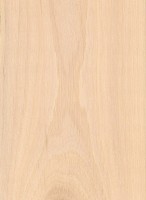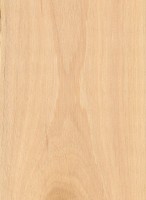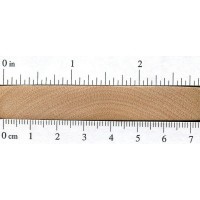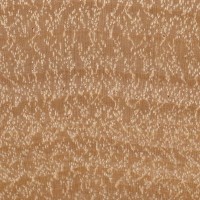 |
Common Name(s): American Hornbeam, Blue Beech Scientific Name: Carpinus caroliniana Distribution: Eastern North America Tree Size: 35-40 ft (10-12 m) tall, 1.5-2 ft (.5-.6 m) trunk diameter Average Dried Weight: 49 lbs/ft3 (785 kg/m3) Specific Gravity (Basic, 12% MC): .58, .79 Janka Hardness: 1,780 lbf (7,920 N) Modulus of Rupture: 16,300 lbf/in2 (112.4 MPa) Elastic Modulus: 1,693,000 lbf/in2 (11.68 GPa) Crushing Strength: 6,500 lbf/in2 (44.8 MPa) Shrinkage: Radial: 5.7%, Tangential: 11.4%, Volumetric: 19.1%, T/R Ratio: 2.0 |
Color/Appearance: Hornbeam’s sapwood is very thick, with most boards and lumber being comprised entirely of sapwood. Color is nearly white. Pale yellowish brown heartwood isn’t clearly demarcated from sapwood.
Grain/Texture: Grain is straight, with a fine, even texture.
Endgrain: Diffuse-porous; small to medium pores, often in radial or diagonal arrangement, (sometimes in dendritic arrangement), moderately numerous to numerous; commonly in radial multiples of 2-4; tyloses occasionally present; smaller rays not visible without lens, with much larger aggregate rays occasionally present, close spacing; parenchyma diffuse-in-aggregates, banded (marginal).
Rot Resistance: Hornbeam is rated as non-durable to perishable in regards to decay resistance, and is also susceptible to insect attack. However, Hornbeam has excellent resistance to wear and abrasion.
Workability: Overall, Hornbeam is considered difficult to work on account of its density and toughness. However, this same density, coupled with its fine and even grain, make an excellent turning wood. Stains, glues, and finishes well.
Odor: No characteristic odor.
Allergies/Toxicity: Although severe reactions are quite uncommon, Hornbeam has been reported to cause skin irritation. See the articles Wood Allergies and Toxicity and Wood Dust Safety for more information.
Pricing/Availability: Not typically harvested commercially for lumber due to its small size, Hornbeam isn’t seen too often for sale. Prices for the wood should be moderate throughout its natural range.
Sustainability: This wood species is not listed in the CITES Appendices or on the IUCN Red List of Threatened Species.
Common Uses: Fuelwood, wheels, handles, shafts, and other small wood parts.
Comments: American Hornbeam is also sometimes referred to as “Blue Beech,” though it is technically not closely related to Beech, but bears a closer resemblance to Birch, being in the Betulaceae family. Also in this family is the somewhat related Hophornbeam (Ostrya virginiana).
The trunks of Hornbeam trees are fluted, which is sometimes still evident in processed lumber—the growth rings in the endgrain may appear more polygonal and faceted rather than perfectly circular.
None available.
 |
 |
 |
 |





In 1910 my grandfather cut down a tree and cut it into toy blocks .
2 generations played with those blocks without putting a scratch in them.
They made a distinctive “plinking” sound when we poured the box of blocks onto the floor.
I didn’t know what that wood was until an adult and herd that distinctive “plinking”
sound again, when when working with some wood from my forest.
It sands to an Ivory smoothness, so pleasing to the touch.
I was digging through a “free firewood” pile and pulled out several logs of very green hornbeam. I’ve put a few on the lathe to turn. The shape lends itself to some really interesting live edge options. It is incredibly heavy and dense, but so far turns pretty nicely, rather like dogwood. I don’t know how it will work when its drier, but it’s been nice so far. The wet wood reacts almost instantly with the lathe chuck, so I am guessing it would ebonize nicely. Other than that, I’d appreciate any finishing tips. Right now my pieces are all… Read more »
rereading my question, I’d like to clarify. I would like to know the ratio of dried weight of hornbeam to the wet (green) weight of hornbeam. I have read that on average, the dry weight will be about 50% of the initial green weight. That is an general approximation based on an average wood types but not specific to hornbeam. Is there any data specifically about hornbeam?
I have a small piece of American Hornbeam that I am trying to dry in a microwave. I recorded its initial weight hours from cutting it down. Any idea what weight (by percentage) it will be when it is considered dry (10%…)? I have not removed any bark or sealed the endgrain.
The horn beam tree is easy to adentifi as the branches grow 90% out of the center of the tree, where most branches on other trees grow up on an angle. This is what makes this tree so hard is because it’s like a piece of rope inside an very difficult to split.
Also known as Musclewood
yeah! And as soon as you see it, you know why. One of the easiest to ID of all those little scrubby smooth barked northeastern trees I learned in college.
You might find it under “Ironwood”.
Where in the world can I find dowels made of American Hornbeam? I just need 3/4″ dowels, 18 1/2″ long.